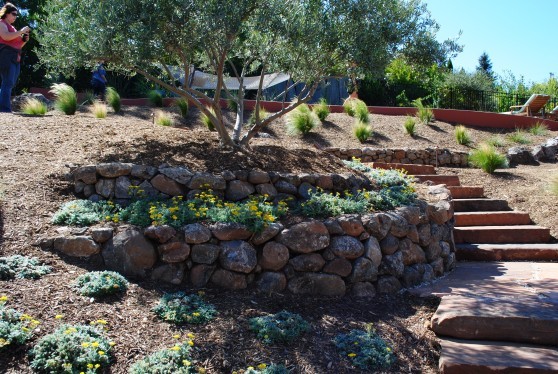Create a retaining wall
Build a small backyard retaining wall using bricks, gravel, and soil with adult supervision to learn about erosion control, stability, and safe construction techniques.



Step-by-step guide to build a small backyard retaining wall
How to Design a Retaining Wall For Beginners
Step 1
Pick a straight spot for your wall and mark the two ends on the ground with small rocks or a stick.
Step 2
Measure the distance between your marks with the tape measure and choose a wall height no taller than 24 inches.
Step 3
With an adult, dig a trench along your marks about 6 inches deep and about one brick width plus 2 inches wide.
Step 4
Bring gravel in the wheelbarrow and pour a 2–3 inch layer into the trench.
Step 5
Use the shovel to tamp the gravel down until it is firm and level.
Step 6
Place the first brick at one end of the trench and continue laying bricks in a straight line to form the first course.
Step 7
Use the level to check each brick so the first course is flat left-to-right and front-to-back.
Step 8
Tap any bricks that are low with the rubber mallet until the level shows they are even.
Step 9
Lay a second course of bricks offset by about half a brick so the joints are staggered.
Step 10
Unroll landscape fabric behind the bricks along the length of the wall so it will separate soil from gravel.
Step 11
Add gravel behind the wall in 2–3 inch layers and tamp each layer down to help drainage and stability.
Step 12
Backfill the top with soil and slope the soil away from the wall so water runs downhill.
Step 13
Press gently along the wall to check for wobble and ask an adult to help fix any loose bricks before finishing.
Step 14
Share a photo and a short description of your finished retaining wall on DIY.org.
Final steps
You're almost there! Complete all the steps, bring your creation to life, post it, and conquer the challenge!


Help!?
What can we use instead of bricks if they're hard to find?
If you don't have standard bricks you can use concrete blocks, pavers, or large flat stones and follow the same steps for placing the first course, gravel base, and tamping.
What should we do if the first row of bricks isn't level or the wall wobbles later?
If the first course isn't level or the wall wobbles, use the level and rubber mallet to tap low bricks, add or remove gravel in the trench, retamp each 2–3 inch gravel layer, and ask an adult to help fix any loose bricks as instructed.
How can we adapt the project for younger kids or older kids?
For younger kids let them mark the ends, help measure, and hand bricks while adults dig and tamp, and for older kids let them measure the distance, dig the 6‑inch trench, lay the first and staggered second course, and check the level themselves up to the 24‑inch height limit.
How can we make the retaining wall look nicer or work better after it's built?
To enhance the wall add a row of capstones or flat pavers on top after the second course, tuck landscape fabric and extra gravel behind the bricks for improved drainage, plant low groundcover in the backfilled soil, and share a photo on DIY.org to show your personalized design.
Watch videos on how to build a small backyard retaining wall
How To Build A DIY Retaining Wall | Complete Step-By-Step Guide
Facts about landscape construction and erosion control
🧱 Ancient engineers built amazing retaining walls — Inca agricultural terraces are over 500 years old and still hold soil for farming.
📐 Builders give walls a slight backward tilt (called a batter) and a compacted base so they stay steady — even small DIY walls use the same idea.
🌧️ Gravel behind a wall acts like a drain — it helps water escape so wet soil doesn't push the wall over.
🌱 Plants and roots are natural helpers: deep-rooted plants can reduce soil erosion and make slopes more stable.
🛠️ With grown-up supervision, kids learn engineering basics (measuring, leveling, safe tool use) by building a tiny retaining wall in a weekend.
How do you build a small backyard retaining wall with bricks, gravel, and soil?
What materials do I need to build a small retaining wall with bricks, gravel, and soil?
What ages is building a small retaining wall suitable for?
What safety tips should I follow when children help build a retaining wall?


One subscription, many ways to play and learn.
Only $6.99 after trial. No credit card required



